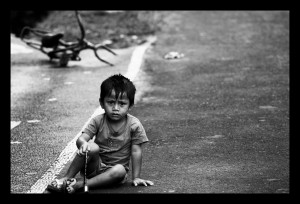Poverty in Bali

Despite welcoming more than 3 million visitors per year and the total from revenue from tourism that is expected to reach US $5.5 billion annually, many of Bali’s inhabitants are living in extreme poverty. But with so much income—$5.5 billion for its 3.8 million Balinese—why is there poverty in Bali?
In Bali, there are as many as 162,051 people living in poverty and this figure has been on the increase. In the villages, the rate at which the number of poor is rising is twice as much as that of Bali’s urban areas. In the Balinese countryside, it is estimated that more than 77,400 people are living in poverty. Currently, in 82 villages out of Bali’s 706 villages, the poverty rate hovers above 35 percent. To make matters worse, on this tourism-focused island where the number of tourists almost matches that of the locals, the incomes of farmers are dwindling and the prices of essential goods are becoming more and more unaffordable to many Balinese.
In remote villages—and “remote” in Bali means an hour or two away from the glittering 5-star hotels—the residents are very poor and most villages lack education, access to clean water and even electricity. Many children must walk for kilometers to go to school. Furthermore, as the more fertile south is overdeveloped, many Balinese are only left with the infertile dry soil of the north and the east to farm on. Due to the lack of jobs and opportunities, men from the villages must also leave to find jobs in the tourism sector, leaving their wives and children. Thus, oftentimes women must work disproportionately, covering both their absent husbands’ tasks as well as their own tasks. In the resort towns, rural migrant workers still earn very little in comparison to what the business establishments whom they work for are earning from tourism. The minimum salary in Bali is only 1,542,600.00 Indonesian Rupiah, or around US $125.
I Made Mangku Pastika, Bali’s governor had made a statement calling the island’s thriving tourism a “disaster” for the poor. He expressed his concern that as prices of basic necessities skyrocket, farmers in need of cash would be forced to sell their land—the only real property they own—in order to make ends meet. The governor had previously fought to stave off further tourism-accommodation developments into the Balinese inland, however due to the political administrative structure, many local authorities ignored his initiative. Trapped in the dilemma of tourism being both the island’s lifeblood as well as—in the words of the governor—a disaster for the poor.
Nevertheless, the governor—now in his second term—is diligently working on solving his island’s economic discrepancy, with many poverty-alleviation plans such as the integrated farming scheme, the installation of solar panels, housing aid and the free healthcare plan. The governor—realizing the injustice of this developmental disparity—also plans to bring down the rate of extreme poverty (people living on less than $2 per day) down from the current figure.
– Peewara Sapsuwan
Sources: The Bali Times, WageIndicator.org, The Bali Times, The Jakarta Post, Australia Network News, The Jakarta Post, Asia News Network,
Photo: Tripping
